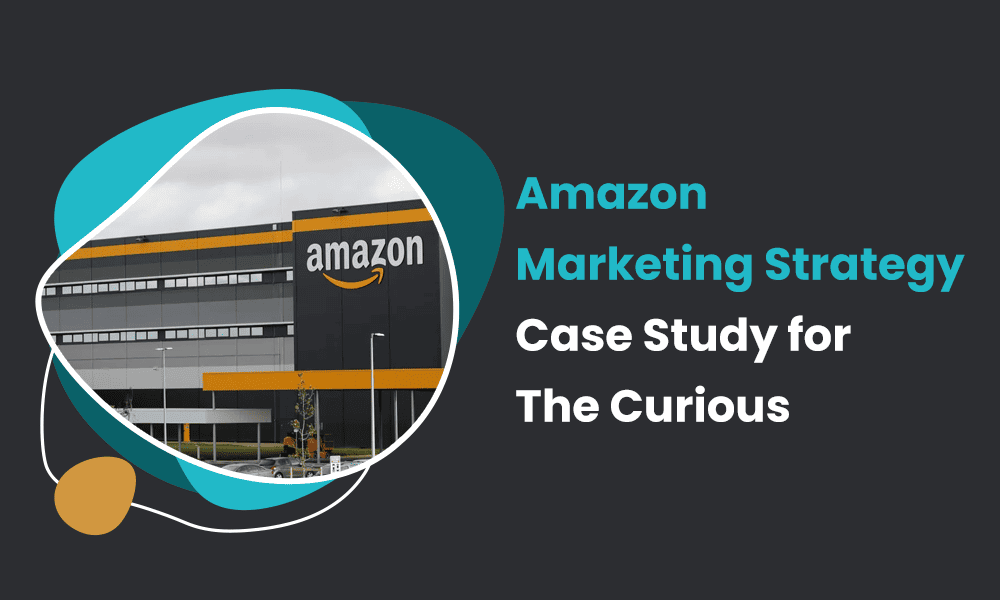According to Statista, Amazon’s net sales revenue went from $61.09 billion to $513.98 billion between 2012 and 2022 – an incredible eight-fold increase. You wonder how much bigger it could get. But, the company certainly has figured out how to do marketing right and keep customers coming back for more.
So, what is it about Amazon’s marketing strategy that makes it so much better than the rest? Well, Amazon closely guards its trade secrets, but if you go through its annual reports over the years, you can glean many nuggets from its marketing playbook – real-world lessons you can apply to your own business. We did exactly that to bring you this comprehensive Amazon marketing strategy case study.
In this blog, we’ll dissect Amazon’s approach to marketing strategy and distill takeaways you can act on right away.
Let’s get started.
Table of Contents
Amazon Business Milestones
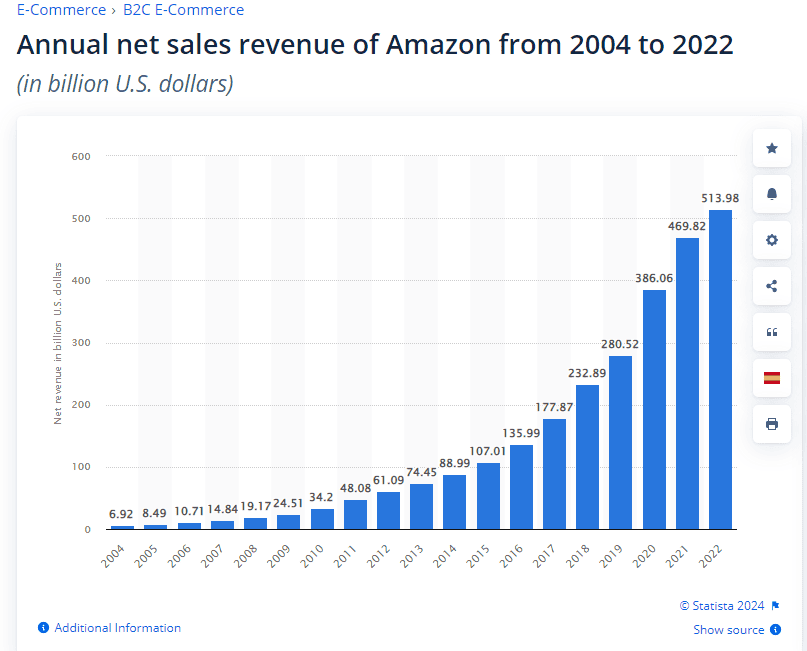
We’ve picked out some key milestones from Amazon’s business timeline to provide context on some of its most consequential marketing strategy pivots.
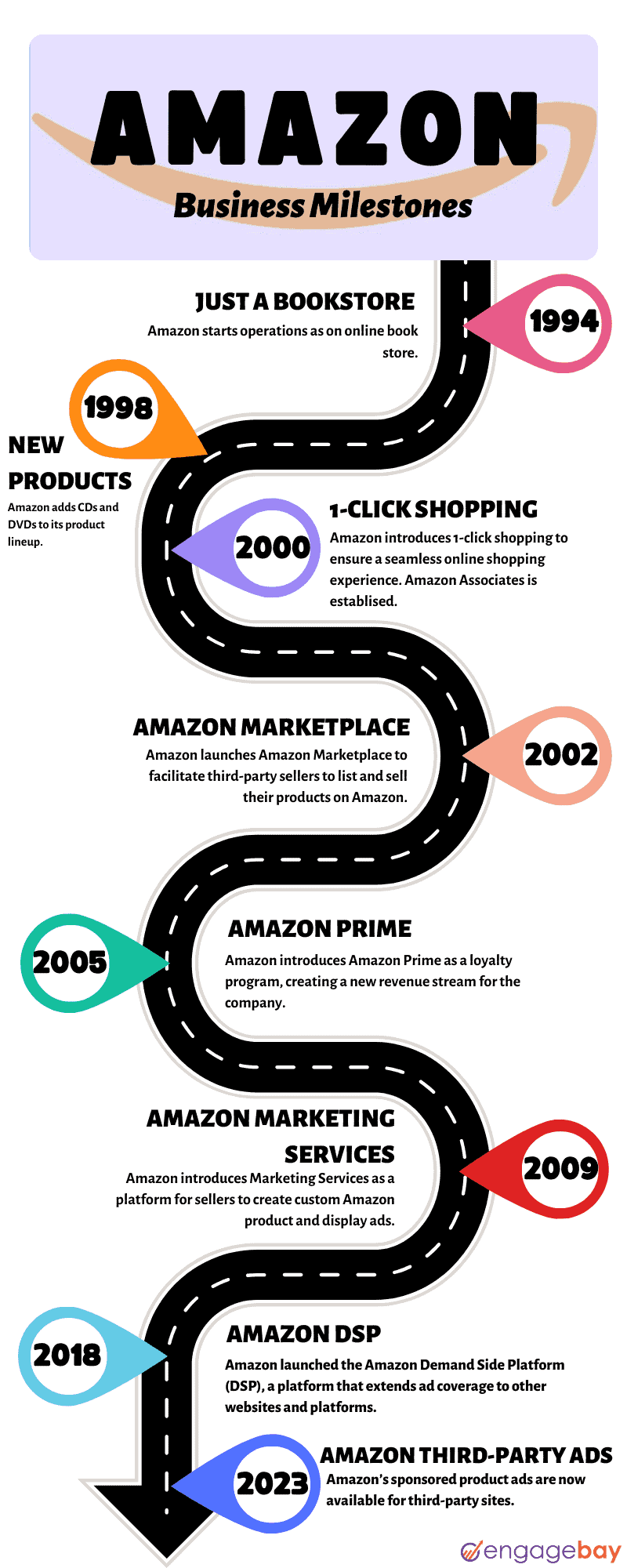
1994
Amazon starts operations as an online bookstore.
1998
The company adds music CDs and DVDs to its product line-up.
1999
Amazon introduces 1-click ordering allowing customers to save their billing and shipping details and check out with just one click. Amazon Associates takes off. Third-party websites could now place Amazon affiliate links and get a commission on each sale they facilitated.
2000
Amazon launches Marketplace – a hub for third-party sellers to list and sell their products alongside its own.
2002
Amazon announces the launch of Sponsored Product Ads for sellers to promote their listings.
2005
Amazon Prime goes live. As an eCommerce loyalty program, it was the first of its kind and created a new revenue stream for the company.
2009
Amazon introduces Marketing Services – a platform for sellers to create custom Amazon product ads and display ads.
2018
Amazon launched the Amazon Demand Side Platform, or Amazon DSP, a platform that extends ad coverage to other websites and platforms.
2023
Amazon’s sponsored product ads are now available for third-party sites.
6 Insightful Amazon Marketing Strategy Case Studies
Here are some examples of how Amazon’s marketing strategy evolved over the years.
1. How Amazon disrupted the market with a fixed-price business model
The challenge
In 1999, Amazon launched zShops, an auction platform to compete with market leader eBay. However, it could barely make a dent. Despite heavy promotion across Amazon.com, the results remained below par.
The solution
Amazon soon realized that the auction model had become saturated. It decided to introduce a new fixed-price marketplace model. In it, each Amazon product page would carry parallel listings from third-party sellers, giving customers more options at the lowest prices.
Used books were the first items to be sold this way. Customers could choose whether to buy from Amazon or a third party. If the customer chooses to buy from a third party, Amazon makes a commission on the sale.
The result
Today, eBay’s revenue is down to some $10 billion, while Amazon’s is leagues ahead of it.
2. How Amazon leveraged free shipping to increase its average basket size
The challenge
Amazon had been exploring the idea of providing free shipping on all purchases over $100 to increase sales. The goal was to encourage shoppers to buy more categories of items per visit, but the numbers weren’t adding up. Some executives felt that free shipping could only be justified as an incentive on large orders, not all.
The solution
After much deliberation, Amazon decided to let customers decide for themselves based on how soon they wanted their orders delivered. The plan was for customers spending more than a certain dollar amount to be shown options for both regular and express delivery at checkout.
A fee would apply if the customer chose express delivery, while regular delivery was free. On the backend, the company decided to utilize spare capacity with express shippers and the postal service to reduce shipping costs. This approach paid off, and Amazon Free Delivery, as we know it today, was born. Since then, Amazon has added additional qualifiers for free shipping.
The result
The company was able to achieve its goal as most customers didn’t mind spending more to get free shipping.
3. How Amazon Prime turned customers into loyal fans
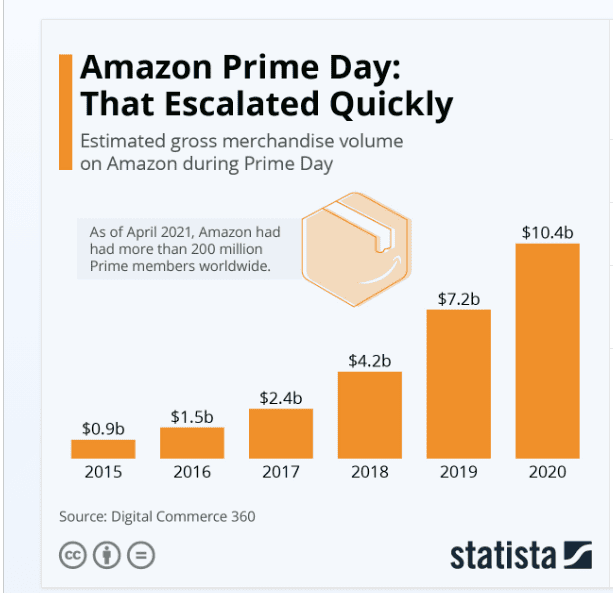
The challenge
Building on the same concept, Amazon launched Prime, the first subscription-based loyalty program anywhere in the world. The team at Amazon wanted to use it as a platform for providing value-added services to customers. However, there was no word on whether it would impact customer purchase habits the way they hoped. The cost of the program, too, was a concern.
The solution
The company’s data showed that customers generally purchased more if there were incentives like free shipping and easy checkout. There was enough evidence to show that order sizes would increase over time, reducing shipping costs.
This meant Amazon could negotiate better deals with its suppliers – resulting in a self-sustaining cycle of improving margins and further discounts. The company went ahead with the plan, and the rest is history.
The result
Today, Amazon Prime has over 200 million customers, bringing in over $35.22 billion in revenue.
4. How A/B testing resolved internal conflict over placements at Amazon
The challenge
In the absence of performance data, Amazon category managers often fought with each other over which promotion would feature on the home and category pages. This resulted in Amazon.com placements being decided arbitrarily.
The solution
The company scrapped the manual process for deciding placements and now uses A/B testing extensively to decide placements. The focus is on testing different placement options over a few days and measuring engagement metrics like page views, session time, and conversion rate. This data is used to determine what promotions would be run.
This is an ongoing task as customer preferences change often, and the team knows it needs to evolve the user experience accordingly.
The result
Real-time testing and experimentation are now a part of Amazon’s culture.
Read also: Where to Sell Handmade Items Online Globally
5. How Amazon embraced dynamic web page layouts to capitalize on changing customer preferences
The challenge
As more sellers started getting on Amazon, changing the site navigation now and then wasn’t going to be enough. The team felt the need to make the website more responsive in terms of featured categories and offers. The existing software solutions on the market didn’t offer the functionality they sought. Amazon needed an in-house solution to improve the user experience.
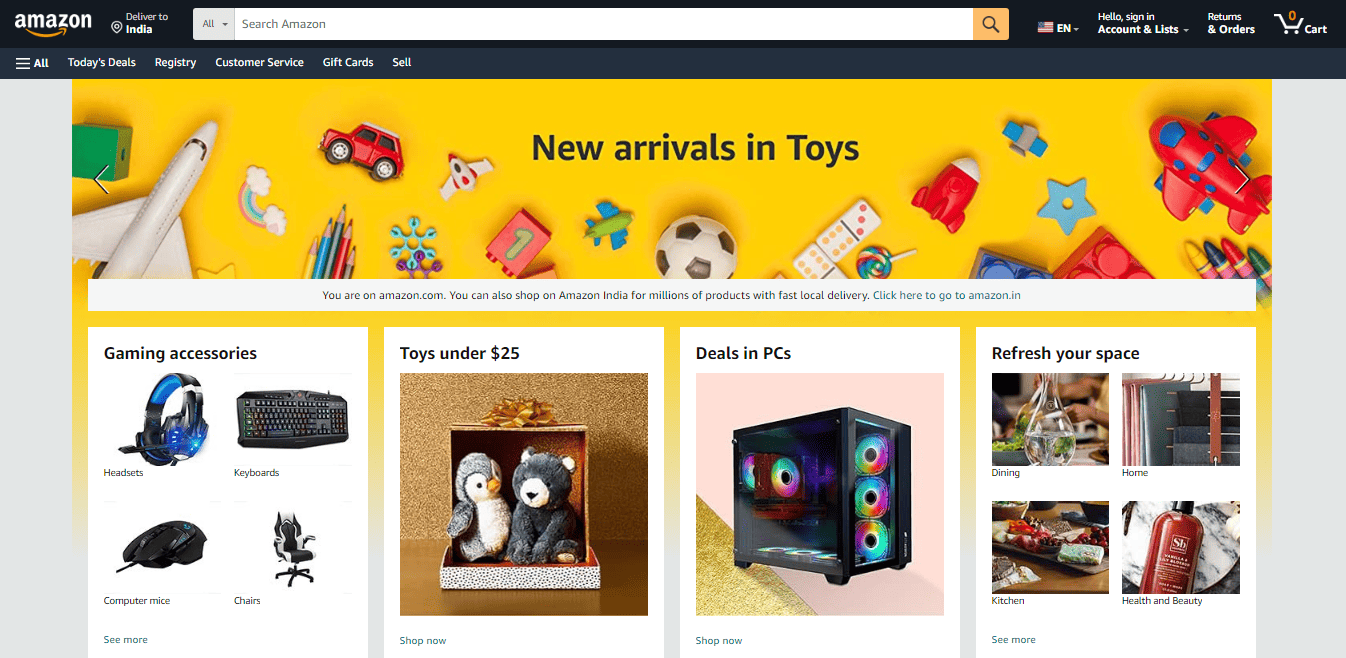
The solution
Using in-house technology, Amazon implemented dynamic feature sections or ‘blocks’ (on-page) that could pull information from various web servers. This allowed the content in each section to be refreshed rapidly based on specific promotions, optimum use of on-page space, and an improved user experience.
The result
Fluid page design technology is now widely used across Amazon websites and apps.
6. How Amazon adopted automation to optimize ad bidding and management
The challenge
With Amazon ad volumes going up fast, the manual process Amazon had been using couldn’t keep up. The company wanted to use real-time conversion data to update bids for sponsored products and other ads.
The solution
Following Google’s lead, Amazon decided to implement automated bidding technology. In 2015, the Amazon Advertising Console was launched as an automated tool for sellers to run sponsored ads. It could identify keywords, create ads, update bids, and track real-time ad performance.
The result
This allowed sellers to identify new keyword opportunities and adjust their bids most effectively.
Read also: What is Amazon FBA? Fees, Requirements, and Optimization
What Is Amazon’s Marketing Mix?
As Amazon went from targeting specific markets to “selling anything and everything from anywhere,” its digital marketing strategy evolved. It focused mainly on online strategies since starting in 1995 but is now coming full circle with Amazon Go –its retail venture. Let’s take a look at its marketing mix.
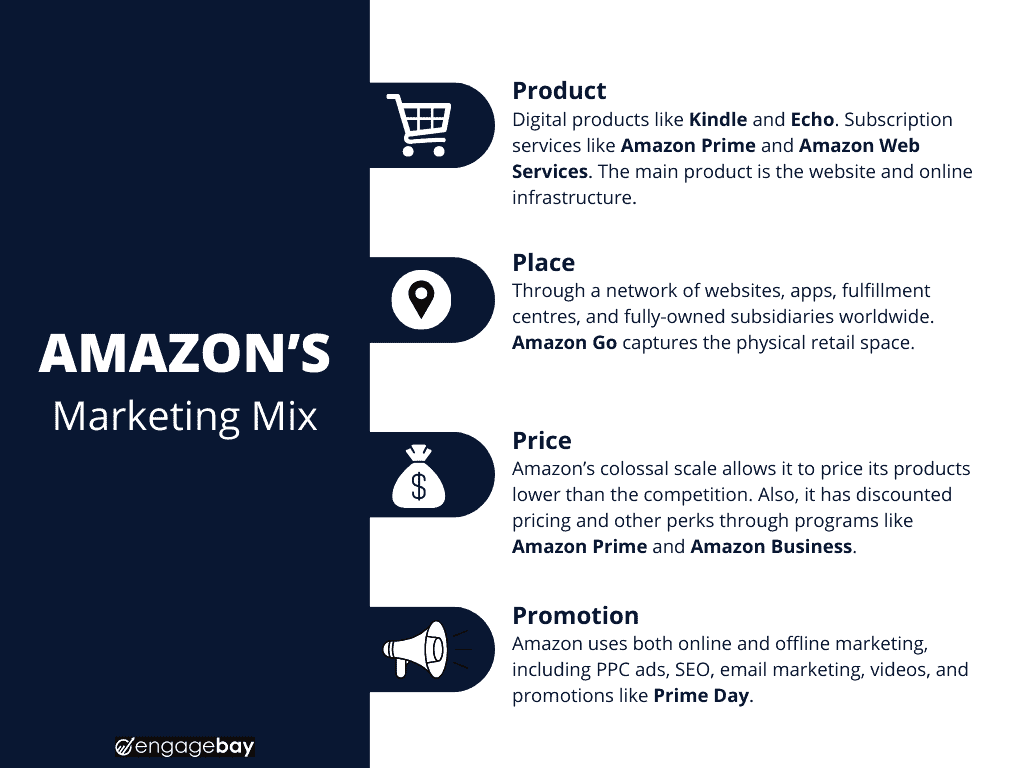
1. Product
Amazon offers a wide range of products, including books, music, electronics, clothing, and more. It includes not just physical products like Kindle and Echo but digital and subscription services like Amazon Prime and Amazon Web Services as well.
However, its main ‘product’ is the website and online infrastructure itself. The highly diversified product lines allow Amazon to benefit from economies of scale and insulate it from revenue fluctuations.
2. Place
Amazon operates through a network of websites, apps, fulfillment centers, and fully-owned subsidiaries around the world. With Amazon Go, it has now entered the physical retail space. There are now 23 stores across the US as of November 2023. This enables Amazon to target a wide range of customer demographics and buying motives.
3. Price
Amazon’s scale allows it to price its products lower than the competition. However, prices for the same product can vary from region to region. This is because the company uses a dynamic pricing strategy that adjusts based on local demand, competition, and availability.
Amazon tracks trending products across categories and then sells them at a discounted price. It also offers additional discounts based on various promotions and loyalty program memberships such as Prime and Amazon Business. An adaptable pricing strategy helps Amazon attract repeat customers and increase average order value.
4. Promotion
The company uses a combination of online and offline marketing strategies to attract and retain customers. This includes PPC ads, SEO, email marketing, video, website marketing, etc. It also runs annual promotions like Prime Day to drive sales and revenue.
Read also: How Amazon’s Competitors Are Gaining an Edge Over the Giant
Some More Components of the Amazon Marketing Strategy Playbook
Now, let’s dig a little deeper and look at more pages from the Amazon marketing playbook.
1. Amazon’s SEO strategy
Amazon’s search algorithm ranks product listings based on keywords and sales conversions. More sales automatically give you a higher search ranking. A higher page rank increases the chances that the right people will see your ad, increasing the probability of conversion.
The effectiveness of this strategy can be gauged from the fact that 50% of all product searches today start on Amazon. Lately, the company has been asking sellers to use a built-in AI tool to create product descriptions.
2. Amazon’s content marketing strategy
The typical product listing on Amazon will have product images, demo videos, charts, side-by-side comparisons, and descriptions to cater to different consumer preferences. Sellers also have to comply with specific guidelines in terms of grammar, special characters, image quality, exaggerated claims, etc., to make their pages reader-friendly.
This helps customers make faster buying decisions, and Amazon is often the first place they go to when searching for products.
Read also: How to Sell Handmade Jewelry Online in 7 Easy Steps
3. Amazon’s advertising strategy
Amazon uses a variety of sponsored product ad formats on its platform, Google, and third-party sites to drive traffic and sales. For example, Google Shopping Ads, BuzzFeed, Mashable, etc. This expands its reach and increases revenue potential. It also capitalizes on Amazon-related keywords to ensure higher rankings in search results than other sellers.
In general, most sellers prefer Amazon ads because their targeting capabilities are more conversion-oriented than search engines.
4. Amazon social media marketing strategy
Amazon uses Facebook, Twitter, and other social media platforms to promote products via exclusive deals, contests, influencer campaigns, and live streams. Social media campaigns also retarget customers who may have clicked on a listing but didn’t complete a purchase.
With live streams, the company demonstrates products and engages in Q&A with customers, while the user-generated content (UGC) from the various challenges and contests goes into generating more engagement.
5. Amazon’s email marketing strategy
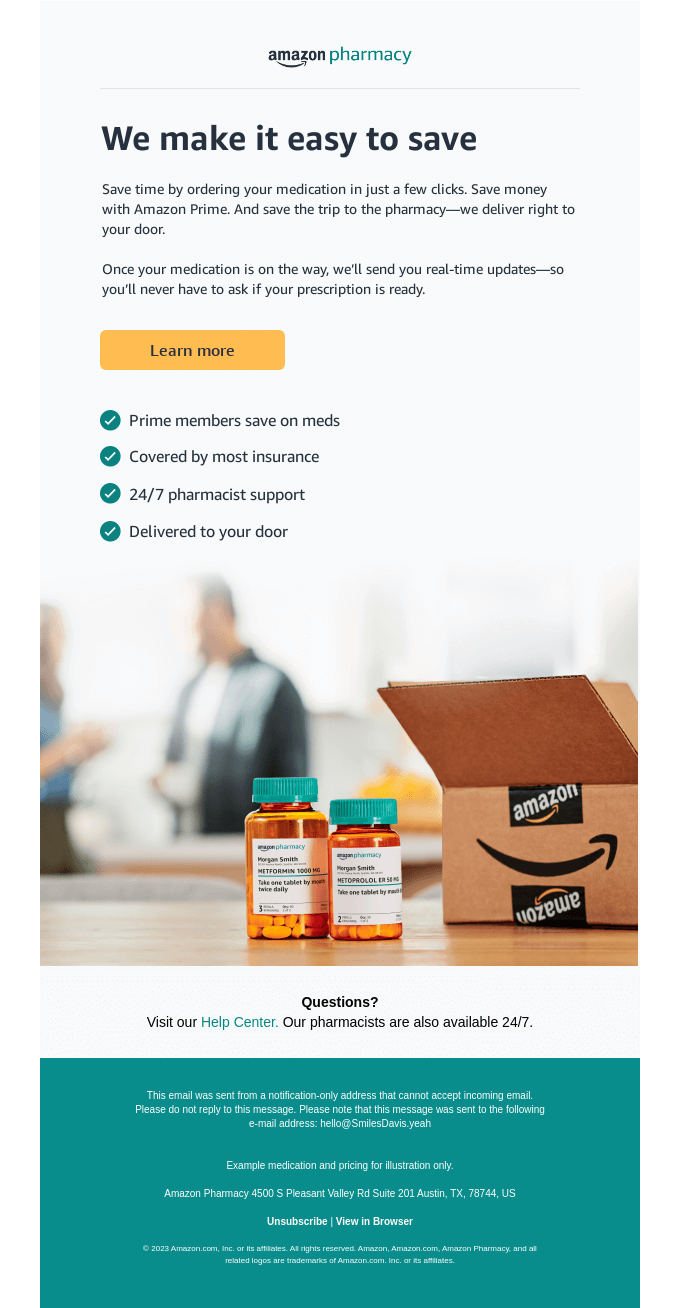
Order confirmations, updates, cart abandonment, newsletters, promotions, and product recommendations – Amazon uses email marketing across the eCommerce customer journey. In addition, it also leverages it to request customer reviews and feedback in the post-purchase stage.
This data is used for process improvement. Other than that, Amazon also provides Prime members with account updates via email. With EngageBay, you can create custom eCommerce email campaigns for each of these touch points and guide customers along the sales funnel.
Read also: Click to Cart — The Art of Crafting Irresistible eCommerce Promotional Emails
5 Marketing Strategies You Can Borrow From Amazon to Grow Your Business
Amazon may be a trillion-dollar brand, but many of the same strategies can help small and medium businesses (SMBs) drive customer loyalty and revenue growth. Here are a few of them.
1. Personalize the customer journey through activity data
Amazon has leveraged personalization to fuel its growth over time. If you want to understand customer behavior, improve customer experience, and get better ROI on your digital marketing efforts, analyze their activity for clues. It can also help you align processes and systems for improved efficiency and cost savings.
2. Think customer first when it comes to website navigation
As we’ve seen in the Amazon marketing strategy case study above, you want to make it as easy as possible for customers to buy on your website. Optimize the search bar by enabling auto-complete and predictive suggestions and ensure it’s visible to customers on their smartphones.
Draw inspiration from Amazon’s one-click search functionality and continuously improve the search function to increase engagement and sales.
3. Leverage multichannel marketing to increase reach
Multi-channel marketing can be used to appeal to different buying motives and customer needs. The right strategy can help customers move through the sales funnel faster. The key is integrating data from all channels and paying attention to touch points with the most traffic.
EngageBay integrates email, social media, video, landing pages, website, and mobile so that you can engage customers across the funnel and drive them to conversion.
Read also: 16 Top Business Movies Every Entrepreneur Must Watch
4. Build relationships with post-purchase emails
Follow up with a thank-you email sequence that includes upsell and cross-sell product recommendations. Set up triggered emails depending on the response; if nothing works, use it to ask for reviews. Since the time window is short, you’ll need to integrate your CRM and email marketing platform for real-time tracking.
5. Let reporting data and analytics lead the way
Very often, customers may have genuine reasons for abandoning their carts. It could be that they have concerns regarding site security, payment modes, or return policy. Integrating a feedback form on your checkout page lets you capture customer sentiments in real-time.
EngageBay’s built-in form builder syncs all customer submissions to CRM in real-time. This can help you spot patterns in customer activity and take appropriate remedial action.
Wrap Up
That’s it for now.
If you liked this article, share it so it can reach more people like you.
For more marketing strategies and tips, head over to the EngageBay blog.
